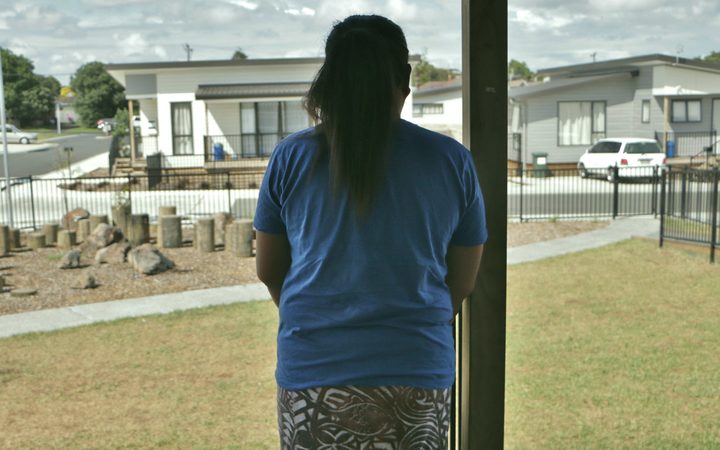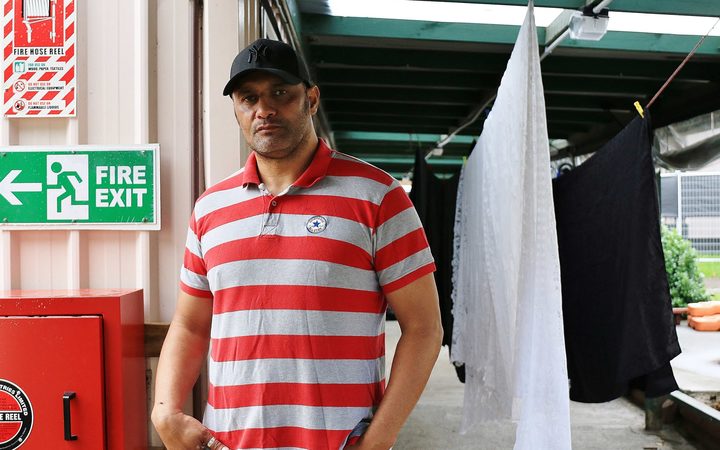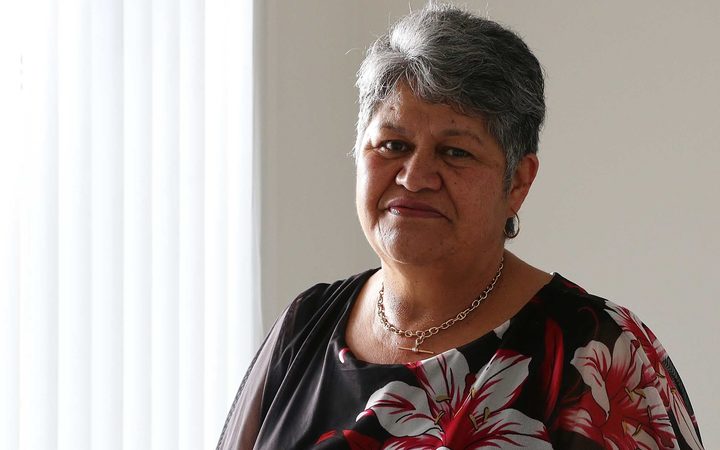Case Study_Monte Cecilia_FINAL

Maria is exhausted. The solo-mother to seven children under 17 years-old has been searching for somewhere to call home for almost a year.
Wearing a faded blue T-shirt and brown floral lavalava, she cups her hands in her lap and speaks softly about the difficulties she has faced trying to find a house big enough, and cheap enough to live in, since moving from Samoa to New Zealand six years ago.
Occasionally, she talks through tears.
Maria is sitting in the Ōtāhuhu office of an emergency housing provider, Monte Cecilia Housing Trust, with her advocate, Vaima’a Memea.
The office sits amongst a complex of temporary houses built for families like Maria’s. The small cul-de-sac is new and tidy, with grassed areas for children but the offices onsite are tell-tale signs that these houses are not owned by those who live in them.
Many of those who come to the Trust in desperate need have more than four children and almost all are Pasifika or Māori.
Maria has searched for private rentals across Auckland but said she was stone-walled by landlords when they realised she had seven children.
“It’s so hard to get a house for me and my seven children,” she said.
In the past, she felt she had no option but to lie to landlords to secure a house. Her tenancies would be shadowed with fear and worry as she tried to keep up the facade of only having four children. When an inspection from a visiting landlord would roll around, she would keep her young children out of sight, often at friends.

Maria looks out over the temporary accommodation she calls home for now. Photo: RNZ Insight/Eva Corlett
Maria moved to New Zealand with her husband in search of a more prosperous life and a good education for her children.
As the house prices and the population ballooned, so did the cost of rentals, and without wages rising to meet the new costs, many were locked out of the housing market.
None more so than the Māori and Pasifika communities.
After a period of time living in Auckland, Maria and her family couldn’t afford their private rental anymore and began the arduous task of searching for a new home. They failed.
A family friend took all nine members in before they ended up in the Ōtāhuhu emergency accommodation in April last year. She has been looking for social housing ever since.
Soon after, her husband developed problems connected to alcohol and the pair split up. Now, Maria is the sole provider for her family and faces finding a house alone.
Maria is extremely grateful to Monte Cecilia Housing Trust for finding her somewhere to stay but while it offers comfort, it also puts her life in limbo. The constant house-hunting and instability leaves Maria exhausted.
“If we get a home…then I will be focusing on everything I have missed out on in life.”
“I want to be like other families, who can go out and do whatever they want,” she said.
Once she gets a home, she wants to sit her driver’s license so that she can ferry her children around and go to markets and events over the weekend and to eventually drive to work.

The temporary homes at Te Puea Marae. Photo: RNZ Insight/Eva Corlett
Maria’s situation is not an unusual one for larger families, especially those living in Auckland – the biggest Pasifika city and one of the least affordable in the world.
These communities have some of the lowest home ownership rates in the country – less than 40 percent of Pasifika and 50 percent of Māori own their home, compared to 70 per cent of Pākehā.
Many families are multi-generational, while others have multi-family living arrangements. But with private rentals out of reach, many families are forced to bunk in with others, leading to the chance of eviction through breaching tenancy agreements over the number of people living in a property. There are also the risks to health caused by overcrowding. And when staying with friends or family isn’t an option, people are sleeping in cars, garages and on the street.
The 2013 census shows that two in five Pacific people and one in five Māori live in overcrowded housing, compared with one in 25 Pākehā.
Housing New Zealand manages just over 8000 houses with four bedrooms or more out of around 63,000 homes in stock nationwide.
The latest figures released to Insight, by Housing New Zealand, show that at 31 December 2017, there were 46 houses that had four or more bedrooms vacant and ready to let to families across New Zealand.
The figures did not include transitional or emergency housing, nor council-owned or community-owned social housing.
Ministry of Social development figures, also released to Insight, show there are 707 families waiting for larger houses and most of those are Auckland-based Māori and Pasifika families.
The Monte Cecilia Housing Trust – set up to help homeless families – housed 235 families last year and assisted 545 families with 919 children. Like other housing groups around the country is at capacity and has a waitlist with up to 40 families.

Tu Maia Ki Te Ao – new social housing on Massey Road, Otahuhu. crp Photo: RNZ Insight/Eva Corlett
The situation is dire, according to one of its social workers, Vaima’a Memea.
“You’ve got large families going into motels that are two-bedroom and paying $3000 per week,” she said. “Then you’ve got the substandard boarding houses, where they’ve only been given one room.”
The price keeps escalating for larger families, as they try to find larger homes. “Where are they supposed to go? I’ve seen it week in and week out – families that are just on the go, every week.”
“It breaks them; breaks their spirit. Is the hope there? No. It’s gone.”
Part of the issue is down to a set of guidelines imported from Canada that social housing providers use to determine how many people can live in one room, say community housing organisations.
The Canadian National Occupancy Standards determine room sharing, based on the ages and gender of those living in them. A girl aged 11 years-old and a boy aged 9 years-old cannot share a room for example, and there are two people to a room tops.
The guidelines are there to prevent overcrowding and minimise health-risks associated with cramped living but those working in community housing say they’re too restrictive and not culturally appropriate for a Pacific nation.
Ms Memea said it can be the difference between a family getting a home or being forced into precarious living.

The chair of Te Puea Marae, Hurimoana Dennis, said housing is about more than just bricks and mortar. Photo: RNZ Insight/Eva Corlett
Up the road from Monte Cecilia’s emergency accommodation is Te Puea Marae, in Mangere Bridge. It opened its doors to homeless families two years ago and was swamped. One of the biggest challenges is finding homes for large families.
It’s chair Hurimoana Dennis said Māori families don’t reflect typical Pakeha families with two parents, two kids and a couple of pets. It was far more likely for multi-generations to be living under one roof, he said.
The focus on housing families from these communities goes beyond just putting up houses.
“Bricks and mortar is a good sell – you can touch it and cut the ribbons – but there hasn’t been a lot of thought about the character of the families we’re putting in them.”

Te Puea Marae encourages families to cook and clean after themselves. Photo: RNZ Insight/Eva Corlett
Other community providers such as the Airedale Property Trust and Te Taha Māori Property Trust echo calls for partnership, saying government won’t remedy the housing crisis alone – especially when it comes to matching the needs of Māori and Pasifika. Those groups believed the government must continue to financially support and encourage community providers.

Te Taha Maori trust chair Arapere Ngaha. Photo: RNZ Insight/Eva Corlett
Housing Minister Phil Twyford appears open to new models of ownership and design.
“With Māori and Pacific, there is a particular aspiration to have inter-generational living,” he said, and traditionally, New Zealand hasn’t built housing that “meets those aspirations”.
But KiwiBuild and large scale developments offered an opportunity to rethink housing, Mr Twyford said.
The government plans to work with iwi, housing groups and the private sector to build homes, including for those with inter-generational needs, he said.
CHA Newsletter - 17 December 2025
CHA Newsletter - 2 December 2025
Community Housing Aotearoa Newsletter - 3 November 2025